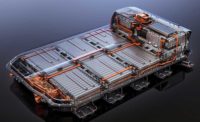When most people think of leak testing, one childhood event probably comes to mind: Submerging a filled bicycle inner tube in a sink full of water, hoping to find the exact leak location by following a trail of air bubbles. This method of leak testing, known as bubble immersion (BI), is frequently used by manufacturers on parts that can be internally pressurized with air and not be damaged by water.
Inner tubes, flow meters, medical device packaging and many other products meet both of these test criteria. Lithium-ion batteries, however, do not. This is true regardless of their size, whether small enough to use in a cordless tool or snow blower, or large enough to power a plug-in hybrid or fully electric vehicle (EV).
EV batteries feature hundreds of cells that contain electrolyte. They also have a multicomponent cooling system that contains refrigerant. Neither of these liquids should ever mix with water. Equally important, applying relatively high air pressure (25 psi and greater) to these battery components could cause their thin, sensitive plastic and metal housings to overexpand and rupture. Add in the fact that the BI method is not precise enough to use on parts with tight leak requirements, and it’s understandable why other air-based and tracer gas methods are better suited for leak-testing these components.
OEMs and Tier 1 and 2 suppliers are well aware of this, having used these methods for decades to leak-test standard automobile parts. This experience, combined with leak-detection systems that are more sensitive, accurate and flexible than ever, enable these companies to produce EV batteries that are leak-proof at every level: cell, module, cooling system and battery pack housing.
Healthy Cells
The smallest element within a battery is the cell, which produces 3 to 4 volts of power. It mostly contains electrolyte, with a middle separator inside and a cathode at one end and an anode at the other, explains Thomas Parker, North American automotive sales manager at Inficon.
Cells come in three shapes. Round cells (also known as type 18650, 20700 or Tesla’s 21700) resemble a soda can, whereas prismatic cells are rectangular in size and have a stable housing. Pouch cells have no housing and may look like zip-closure bags.
“One goal of leak testing is to keep all liquid and water vaper out of each cell,” says Parker. “The other is to keep all refrigerant or coolant contained within the cooling system. Water vapor can creep into a cell, condense and react with the electrolyte to form hydrofluoric acid that kills the cell. Water can also penetrate into modules and packs to short-circuit the battery.”
Each cell design has specific areas where leaks are likely to occur. For round cells, it’s the crimped connections between the cylindrical housing and the cathode and anode contacts. Pouch cells are at risk of leaking from the bag’s sealing, the electrode feed-throughs and tiny holes caused by post-closing handling processes.
Prismatic cells can leak in many areas: The weld seams between the cover plate and the two electrode contacts, the bursting disc welded into the cover plate, the weld seam between the cover plate and the lower housing part, and the seal of the opening for electrolyte filling.
Regardless of cell design, the battery manufacturer may specify that the cell housing be pressure or vacuum decay leak-tested before it is filled. In pressure decay, the part under test is pressurized, then isolated from the supply pressure. A sensor monitors internal pressure, which drops as the air leaks out. The leak rate is then calculated based on the change in pressure over a certain period of time.
Vacuum decay is similar to pressure decay, but, instead of pressurizing the part, a vacuum is created inside it. A sensor monitors the internal vacuum level, which decays as the air leaks in. The leak rate is then calculated based on the change in vacuum over a certain period of time.
“Leak testing at the cell, or subassembly, level is always preferred because it can save the manufacturer money,” says Rob Plumridge, leak test specialist at Sciemetric Instruments Inc. “The more value that’s been added to the battery by the time it’s tested, the more costly it becomes if any part leaks.”
The 3520 air-based leak test module from Sciemetric offers repeatable cycle times with high throughput for pressure-decay or mass-flow testing. It has a fill rate of up to 300 standard liters per minute and features onboard automatic diagnostics, self test and calibration routines. Easy to maintain, the module also works with the company’s sigPOD controller.
Before the cell housing is sealed, a small amount of helium is added, enabling the cell to be leak-tested using the helium hard vacuum method. This technique involves placing the cell in a vacuum chamber and evacuating it so gas leaking out of the cell can be detected by a mass spectrometer.
According to Parker, some hard vacuum testing of prismatic and pouch cells requires an approach known as bombing. This involves exposing the cell to helium under high pressure so the helium penetrates into the cell through any leak. The cell is then placed in the vacuum chamber, where test gas leaking out of the part is detected.
Pouch cells need to be placed in a support structure during bombing. Otherwise, their flexible-envelope sealing seams may be deformed by the vacuum pressure and risk leaking electrolyte.
Some manufacturers also do audit testing of filled cells. Jacques Hoffmann, founder and president of InterTech Development Co., says two Asian battery manufacturers asked his company in 2016 to perform audit leak-testing of filled cells using the helium hard vacuum method.
InterTech’s M1075 leak tester uses a small mass sensor with quick reaction and recovery time back to zero. The air-based tester also requires a low pressure drop across the sensor to obtain a measurable flow. It operates as a stand-alone instrument or can be easily interfaced with a PLC or PC.
The unit’s touch screen control panel displays test cycles in real time and stores up to 99 test programs and 40 million test results. This instrument has also been successfully used to leak-test EV-battery-cooling-system components, including chiller pumps and valves.
No Leaking of the Pack
Sealed cells that pass all leak tests are stacked and welded into a battery module, which can contain up to several hundred cells. Welding completes the electrical path for current flow between the cells. The module also features a temperature monitor and a control unit that regulates battery power discharge.
Several modules and a cooling system fill most of the battery pack. Each of these components, as well as the pack housing, are leak-tested separately using an air method (to verify the presence of a leak) followed by a helium one (to exactly pinpoint the leak).
The cooling system consists of formed-aluminum tubing positioned around the modules or small heat exchanger plates (or thermal fins) between them; medium-size heat exchanger plates between stacked modules; a large heat exchanger plate below all modules; and an electronics cooling unit, notes Parker. Tubing is used with round cells, and plates with prismatic cells. The coolant in these components is either a water-glycol mix or a refrigerant such as R1234yf.
Leak-testing ensures that no coolant enters the battery module, thereby protecting its inner cells and outer electronic components (voltage inverter, controller, main fuse, service disconnect, cables, etc.) from shorting out during vehicle operation. It also maintains proper air conditioner performance when a bypass from the vehicle’s AC system is used to cool the batteries.
Last fall, Inficon introduced its LDS3000-AQ leak detector that uses forming gas or helium in a simple accumulation chamber. It is sensitive enough to detect leaks down to 10-5 millibar liter per second for both gases. The unit is also able to communicate its test results through several analog and digital interfaces such as EtherNet IP.
“In an EV-lithium-battery system, water is the enemy because electrolytes and water do not mix,” says J.P. DeLuca, leak detection product manager at LACO Technologies Inc. “Any bit of water vapor could damage the battery.”
LACO’s TitanTest helium mass spectrometer leak detector can be used to test various EV-battery parts, from individual cells to the final battery pack. Its various features, including the flexible ATLAS process controller, deliver a robust automated solution with helium management and data logging to meet tight specification requirements.
The recommended leak-test method for cooling-system components is helium atmospheric accumulation rather than air pressure decay, due to their high sensitivity to temperature changes. In the accumulation method, tracer gas escaping the part is allowed to accumulate in an enclosure that surrounds the part at atmospheric pressure. The accumulated gas is mixed and sampled by a mass spectrometer.
Manufacturers like that this method requires no expensive vacuum chambers or pumps, and that it tests for overall part leakage. Leak rate requirements for these components range from 10-3 millibar liter per second for a water-glycole mixture, to 10-5 for refrigerant.
The battery housing is rectangular or T-shaped, made of plastic, aluminum or steel, and joined with removable bolts. Depending on the manufacturer, the housing can be leak-tested empty or full using the pressure decay, accumulation or sniffing method. The latter approach involves filling the housing with helium and scanning a sniffer probe (attached to a helium leak detector) over the part to measure out-leakage at suspect locations. Production volume will determine whether a person or a robot manipulates the sniffer probe.
Testing Challenges
Leak testing EV battery components presents some challenges. One is the environment where testing is done, especially for companies that use the same piece of equipment to perform air-based tests on different parts.
“Often times, air temperature can prevent the manufacturer from getting the test-result reliability they expect,” notes Anne Marie Dewailly, technical director at ATEQ Corp. “This is because, as air temperature goes, so goes the pressure level introduced into the part. Testing under an air conditioner or fan, for example, will lower air temperature and pressure, whereas a warm area will have the opposite effect.”
The ATEQ Primus S air leak detector is especially effective for pressure-decay testing battery cells, says Dewailly. A compact machine, the detector offers a leak measurement range from 50 to 5,000 pascals of pressure. The unit not only compensates for temperature variations; it learns from the results it gets and adapts itself to those results in a smart way.
Air contains a natural concentration of helium (5 ppm), and this amount sets the base line in many leak-testing applications. DeLuca says that helium management is a must to prevent additional helium background that could slow down test cycles and/or possibly produce false readouts during testing. This is why LACO offers custom helium management solutions for all applications.
“End-users need to always limit the amount of vacuum when testing EV-battery cells or modules,” advises Gordon Splete, marketing director at Cincinnati Test Systems Inc. “Full vacuum may cause lithium cells and packaging to rupture.”
The TracerMate CS from Cincinnati Test is a gas management instrument that works with a wide range of helium leak-detection units. It hooks up to a gas source and uses internal pneumatics for part evacuation and backfill. According to Splete, the instrument helps operators accurately isolate a leak with a handheld probe at up to 20+ part locations. The device also manages testing sequences, and is sensitive enough for use in small, medium and large leak-detection applications.







